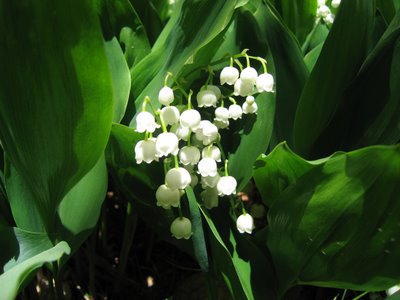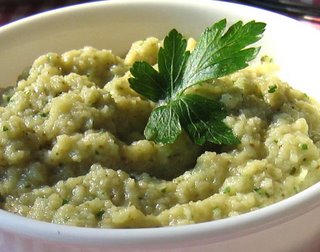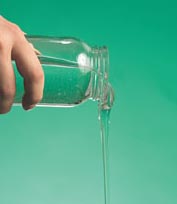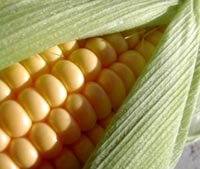
Friday, July 21, 2006
Wednesday, July 12, 2006
Perspective
 "I go to the farmers' market every week and I get most of my produce there. But I'm in a privileged position -- as are many people in this country -- and what works for us doesn't necessarily work for the world as a whole. Look at genetic engineering. The top four food crops of the world -- corn, rice, soybeans and wheat -- feed billions of people, and they take up millions and millions of acres. If you can tweak their genetic makeup so they're a few percent more efficient or require a few percent fewer acres, that translates to huge plots of land. In a lot of ways the industrialization of human life has not been good for the planet. But given where we are, if genetic engineering is properly and thoughtfully applied, it might actually help limit the further encroachment of human activities on the environment by making food production more efficient."
"I go to the farmers' market every week and I get most of my produce there. But I'm in a privileged position -- as are many people in this country -- and what works for us doesn't necessarily work for the world as a whole. Look at genetic engineering. The top four food crops of the world -- corn, rice, soybeans and wheat -- feed billions of people, and they take up millions and millions of acres. If you can tweak their genetic makeup so they're a few percent more efficient or require a few percent fewer acres, that translates to huge plots of land. In a lot of ways the industrialization of human life has not been good for the planet. But given where we are, if genetic engineering is properly and thoughtfully applied, it might actually help limit the further encroachment of human activities on the environment by making food production more efficient."- Harold McGee, Food scientist, author, and contributor to Food & Wine's August, 2006 article What Does Eating Well Really Mean?
Tuesday, July 11, 2006
Eggplant Dip (Baba Ghanoush)
 Also known as The Broom of the System. (Although when precooked, as it is here, it looses the spongy structure noted to soak up oil and lubricate the innards.)
Also known as The Broom of the System. (Although when precooked, as it is here, it looses the spongy structure noted to soak up oil and lubricate the innards.)It's said to have originated in the Middle East (ME). But the ME is a big and disparate place, whereupon some portions have proclaimed their desire to see other portions "vanish from the page of time", or more colloquially "wiped off the map". It's so heterogeneous, in fact, that eggplant dips exist in various forms, depending on the region or culture. They're often seen made with tahini (sesame paste), but some regions spurn the sesame for olive oil; others take a dairy approach with a nice cool-tart whole-milk yoghurt. Baba ghanoush is essentially a dip made from roasted eggplant, pureed with a fat and some flavorings. (I wonder if peace in the ME would amount to standardization of the baba ghanoush.)
This one I made with just olive oil, but some or all of the oil can be replaced with tahini or yoghurt depending on your particular tastes or allegiances. I'm fond of a tahini & olive oil blend myself.
Ingredients
1 eggplant
1/4 cup diced onion
1/4 teaspoon dried oregano
3 to 4 tablespoons freshly squeezed lemon juice
1 teaspoon red wine vinegar
1/2 teaspoon salt
Dash pepper
Dash cumin
Small handful fresh parsley (or fresh mint)
1 clove garlic, minced
1/4 cup olive oil
1 Preheat oven to 350ºF.
2 Wash eggplant. Poke it a few times with a small knife. Place it on a baking dish or sheet and roast for about 45 minutes or until it softens and deflates. Let it cool completely.
 Note: You may also grill the eggplant - it adds wonderful flavor! It will take about the same amount of time on low-to-medium heat. Avoid high heat, it will char the outside without softening the inside.
Note: You may also grill the eggplant - it adds wonderful flavor! It will take about the same amount of time on low-to-medium heat. Avoid high heat, it will char the outside without softening the inside.The time needed to soften will depend on the size and type of eggplant, with larger and denser ones taking longer. The eggplant I used (pictured) was an Italian Blue Marble. It's about the size of a softball or grapefruit, a little meatier and less bitter than the common black globe variety.
3 Peel or slice off the skin and charred bits. Combine eggplant pulp, onion, oregano, lemon juice, vinegar, salt, pepper, and cumin in a food processor and blend until homogenous, less than a minute. Stir the minced garlic into the oil in a small cup with a spout. While the processor is running, slowly pour the olive oil/garlic mixture through a chute until the dip is creamy. Add the parsley or mint and pulse a few times more.
 Notes: If you use tahini, add it in the beginning with the eggplant.
Notes: If you use tahini, add it in the beginning with the eggplant.I mix my garlic with oil to lessen its bitter taste and prevent the garlic from discoloring in the presence of acids.
You can add fresh herbs in the beginning, but the longer you process, the greener the dip.
Baba ghanoush is usually served with pita bread, but any dip surface will do.
Enjoy!
Thursday, July 06, 2006
Surprises, That's All
You can't work in the diabetes field and not be immersed in its complications. There are the acute and traumatic ones, like amputations, kidney failure, and of course heart attack. But most diabetes complications are insidious - quiet, slow to develop, just a nuisance when they first appear, and eventually chronically debilitating if nothing is done to stem their progress. This is not a pretty disease. It surprises me when people take a lighthearted approach to its management.
It also surprises me to hear more people I know getting diagnosed. At a July 4th picnic this weekend, all three of the people I was talking to admitted having it. That could be a function of my age. But I'm also aware that its incidence is on the rise.
By the way, someone needs to come up with a better way to test blood sugar.
That's all.
It also surprises me to hear more people I know getting diagnosed. At a July 4th picnic this weekend, all three of the people I was talking to admitted having it. That could be a function of my age. But I'm also aware that its incidence is on the rise.
By the way, someone needs to come up with a better way to test blood sugar.
That's all.
Wednesday, July 05, 2006
High Fructose Corn Syrup (HFCS)
See this process? (Click for larger.)

This exquisite flow chart came from an article in the July 2, New York Times,
A Sweetener With a Bad Rap.
It's the process from which we derive this:

From this:

It's a process that doesn't look like it would occur spontaneously in nature. So, no matter that the FDA has decided to allow companies to advertise products which contain HFCS as "100% natural" or "all natural", I don't consider them natural (especially when lots of corn in the US is genetically modified). And since my personal consumption goal is to eat as closely to nature as is possible1, or at least is reasonable, I shun foods that are made with HFCS whenever I can.
Fructose Is Not The Bad Guy
That said, I don't believe the fructose in "high fructose corn syrup" should be maligned as much as it is. HFCS may, in my mind, be an unnatural substance, but fructose isn't. It's found naturally in fruits, honey, and some vegetables. Its sweetness is nicely attractive to the human tongue and psyche. I can imagine my ancestors, the ones who lived thousands of years ago, salivating as they plucked a berry and being rewarded for their keen sense of foraging. And I suspect the serpent in the Garden of Eden would have had a hell of a time getting Eve to take a bite of celery instead of apple. Fructose tastes good, baby.
Now, it's true that high intakes (amounts over 50g) of fructose can be difficult to absorb, leading to gas, bloating, cramping, diarrhea, and other generally uncomfortable GI symptoms. It's true that ingestion of fructose has been found to increase levels of serum triglycerides. And knowing the unique way fructose is metabolized in the body, especially by the liver, I wouldn't be surprised to see findings that implicate it in liver impairment. But none of these undesirable outcomes of fructose intake should come into play if the monosaccharide is consumed in moderate amounts - quantities found in a couple peaches, a handful of blueberries, and a teaspoon or two of honey.
It's In The Numbers
Where a medium peach has about 1.5g of fructose, a "small" 16 oz. HFCS-sweetened carbonated beverage can have about 25g of fructose, not counting the amount freed from its sucrose2, another sweetener added to soda. Add a burger to that small beverage, whose bun and condiments are HFCS-sweetened, and a bite or two of any prepackaged HFCS-sweetened dessert, and you'd be a wise fellow indeed to have a route mapped out to the nearest bathroom.
There's an oft-cited article3 that links the consumption of HFCS to obesity. But I wonder if you replaced all our HFCS with plain old sugar, it would significantly impact the obesity prevalence in this country. That would be a telling bit of research.
~~~~~~ 1 For a myriad of reasons, environmental, political, economic, as well as reasons that have to do with my health.
2 Sucrose, or table sugar, is a disaccharide. It consists of 2 monosaccharides - glucose and fructose. Sucrose is cleaved into glucose and fructose in the intestine before being absorbed. So sucrose is also a source for fructose.
3American Journal of Clinical Nutrition, 2004, "Consumption of high-fructose corn syrup in beverages may play a role in the epidemic of obesity".

This exquisite flow chart came from an article in the July 2, New York Times,
A Sweetener With a Bad Rap.
It's the process from which we derive this:

From this:

It's a process that doesn't look like it would occur spontaneously in nature. So, no matter that the FDA has decided to allow companies to advertise products which contain HFCS as "100% natural" or "all natural", I don't consider them natural (especially when lots of corn in the US is genetically modified). And since my personal consumption goal is to eat as closely to nature as is possible1, or at least is reasonable, I shun foods that are made with HFCS whenever I can.
Fructose Is Not The Bad Guy
That said, I don't believe the fructose in "high fructose corn syrup" should be maligned as much as it is. HFCS may, in my mind, be an unnatural substance, but fructose isn't. It's found naturally in fruits, honey, and some vegetables. Its sweetness is nicely attractive to the human tongue and psyche. I can imagine my ancestors, the ones who lived thousands of years ago, salivating as they plucked a berry and being rewarded for their keen sense of foraging. And I suspect the serpent in the Garden of Eden would have had a hell of a time getting Eve to take a bite of celery instead of apple. Fructose tastes good, baby.
Now, it's true that high intakes (amounts over 50g) of fructose can be difficult to absorb, leading to gas, bloating, cramping, diarrhea, and other generally uncomfortable GI symptoms. It's true that ingestion of fructose has been found to increase levels of serum triglycerides. And knowing the unique way fructose is metabolized in the body, especially by the liver, I wouldn't be surprised to see findings that implicate it in liver impairment. But none of these undesirable outcomes of fructose intake should come into play if the monosaccharide is consumed in moderate amounts - quantities found in a couple peaches, a handful of blueberries, and a teaspoon or two of honey.
It's In The Numbers
Where a medium peach has about 1.5g of fructose, a "small" 16 oz. HFCS-sweetened carbonated beverage can have about 25g of fructose, not counting the amount freed from its sucrose2, another sweetener added to soda. Add a burger to that small beverage, whose bun and condiments are HFCS-sweetened, and a bite or two of any prepackaged HFCS-sweetened dessert, and you'd be a wise fellow indeed to have a route mapped out to the nearest bathroom.
There's an oft-cited article3 that links the consumption of HFCS to obesity. But I wonder if you replaced all our HFCS with plain old sugar, it would significantly impact the obesity prevalence in this country. That would be a telling bit of research.
2 Sucrose, or table sugar, is a disaccharide. It consists of 2 monosaccharides - glucose and fructose. Sucrose is cleaved into glucose and fructose in the intestine before being absorbed. So sucrose is also a source for fructose.
3American Journal of Clinical Nutrition, 2004, "Consumption of high-fructose corn syrup in beverages may play a role in the epidemic of obesity".
Subscribe to:
Posts (Atom)